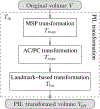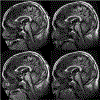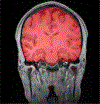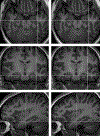A new approach to symmetric registration of longitudinal structural MRI of the human brain
- PMID: 35288224
- PMCID: PMC9008769
- DOI: 10.1016/j.jneumeth.2022.109563
A new approach to symmetric registration of longitudinal structural MRI of the human brain
Abstract
Background: This paper presents the Automatic Temporal Registration Algorithm (ATRA) for symmetric rigid-body registration of longitudinal T1-weighted three-dimensional MRI scans of the human brain. This is a fundamental processing step in computational neuroimaging.
New method: The notion of leave-one-out consistent (LOOC) landmarks with respect to a supervised landmark detection algorithm is introduced. An automatic algorithm is presented for identification of LOOC landmarks on MRI scans. Multiple sets of LOOC landmarks are identified on each volume and a Generalized Orthogonal Procrustes Analysis of the landmarks is used to find a rigid-body transformation of each volume into a common space where the volumes are aligned precisely.
Results: Qualitative and quantitative evaluations of ATRA registration accuracy were performed using 2012 volumes from 503 subjects (4 longitudinal volumes/subject), and on a further 120 volumes acquired from 3 normal subjects (40 longitudinal volumes/subject). Since the ground truth registrations are unknown, we devised a novel method for showing that ATRA's registration accuracy is at least better than 0.5 mm translation or 0.5° rotation.
Comparison with existing method(s): In comparison with existing methods, ATRA does not require any image preprocessing (e.g., skull-stripping or intensity normalization) and can handle conditions where rigid-body motion assumptions are not true (e.g., movement in eyes, jaw, neck) and brain tissue loss over time in neurodegenerative diseases. In a systematic comparison with the FSL FLIRT algorithm, ATRA provided faster and more accurate registrations.
Conclusions: The algorithm is symmetric, in the sense that any permutation of the input volumes does not change the transformation matrices, and unbiased, in that all volumes undergo exactly one interpolation operation, which precisely aligns them in a common space. There is no interpolation bias and no reference volume. All volumes are treated exactly the same. The algorithm is fast and highly accurate.
Keywords: Brain; Image registration; Inverse-consistent registration; Landmark detection; Longitudinal MRI; Symmetric registration; Unbiased registration.
Copyright © 2022 Elsevier B.V. All rights reserved.
Conflict of interest statement
Conflict of Interest Statement
The author has no conflicts of interest to declare.
Figures







References
-
- Ardekani BA, Braun M, Hutton BF, Kanno I, and Iida H. A fully automatic multimodality image registration algorithm. J Comput Assist Tomogr, 19(4):615–623, 1995. - PubMed
-
- Ardekani BA, Kershaw J, Braun M, and Kanno I. Automatic detection of the mid-sagittal plane in 3-D brain images. IEEE Trans Med Imaging, 16(6):947–952, Dec 1997. - PubMed
-
- Ardekani BA, Bachman AH, and Helpern JA. A quantitative comparison of motion detection algorithms in fMRI. Magn. Reson. Imaging, 19(7):959–963, Sept. 2001. - PubMed
-
- Ardekani BA, Convit A, and Bachman AH. Analysis of the MIRIAD Data Shows Sex Differences in Hippocampal Atrophy Progression. J. Alzheimers Dis, 50(3):847–857, 2016. - PubMed
Publication types
MeSH terms
Grants and funding
LinkOut - more resources
Full Text Sources
Medical

